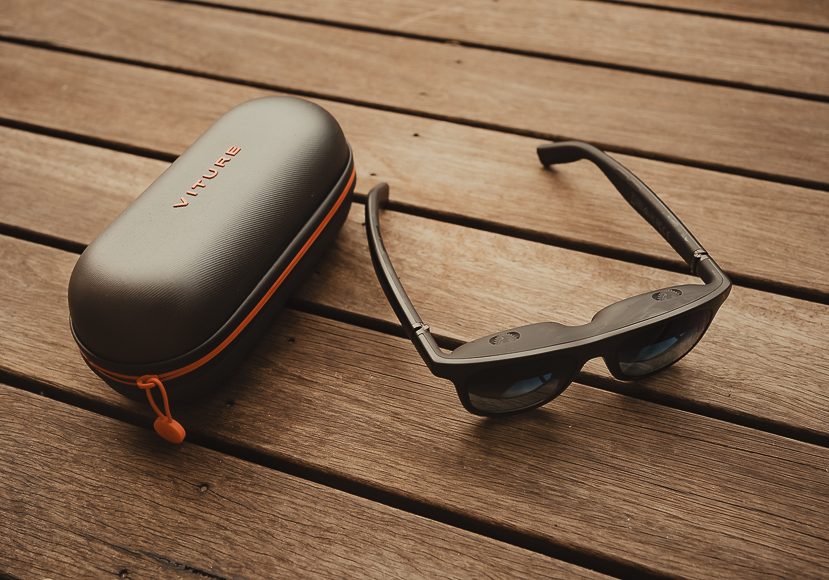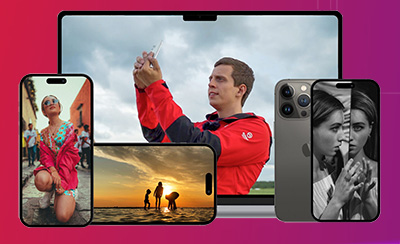
Viture Pro XR Review: Are These AR Glasses Worth It for Creatives?
Looking to edit, cull, or relax with your content on the go? This hands-on review reveals how these AR glasses perform for creatives and frequent travellers.
Photography Gear Reviews | By Jeff Collier | Last Updated: May 23, 2025
Shotkit may earn a commission on affiliate links. Learn more.
This guide to the Viture Pro XR will help you decide if a pair of AR glasses can replace a bulky monitor while traveling, especially for photo culling, video editing, or just escaping into a movie.
As a hobbyist photographer and video creator based in Northern NSW, I was keen to find out how the Viture Pro XR would perform when integrated into my workflow.

Lightweight XR glasses that create a private, cinema-sized screen for entertainment and casual creative use on the go.
I tested the Viture Pro XR with my iPad Pro and MacBook Pro, using it to stream Gangs of London, edit videos in Premiere, cull shoots in Lightroom, and help my granddaughter play a few iPad games.
If you’re curious whether these fun glasses belong in your carry-on or even your camera bag, read on.
What are the Viture Pro XR Glasses?
- Big, sharp virtual display – like a cinema in your seat
- Lightweight, travel-friendly and easy to set up
- Built-in focus sliders for mild myopia (no glasses needed)
- Great for privacy in public or noisy spaces
- Electrochromic lenses boost contrast and immersion
- Plug-and-play with iPad, MacBook, and Android devices
- Slightly warm colour tone — not ideal for final edits
- Onboard speakers are quiet in loud environments
- Focus dials are fiddly to get just right
- Glasses get warm on longer sessions
- Pricey if you need optional add-ons like the Neckband
- Screen moves with your head, which can feel odd at times
At a glance, the Viture Pro XR looks like a slightly futuristic pair of sunglasses.
Inside, they’re a full-featured wearable display with two 1080p micro-OLED screens (one for each eye), projecting a sharp, bright, and surprisingly immersive virtual screen that appears around 135 inches in size.
These aren’t standalone AR goggles – i.e., they don’t run apps by themselves. Instead, they act as a plug-and-play external monitor for your laptop, phone, tablet, or even game console.
You just connect via USB-C, and your device sees them as a display. The glasses draw power directly through the cable. There’s no internal battery to charge, which makes them even more travel-friendly.
They also feature myopia correction (0 to -5D), built-in stereo speakers, and electrochromic lenses that tint at the press of a button, turning transparent glasses into a dark, immersive cinema screen.
Technical Specs
- Display: Dual 1080p OLED (one per eye), up to 120Hz
- Virtual screen: ~135” at 3m distance, ~46° FOV
- Adjustment: Myopia dials (-5D to 0), swappable nose pads
- Lenses: Electrochromic tinting at the press of a button
- Audio: Open-ear stereo speakers, beamforming mics
- Weight: ~77g
- Connectivity: USB-C (DisplayPort Alt Mode)
- No internal battery — powered by host device
First Impressions & Comfort

My son-in-law Mark wearing the Viture Pro XR glasses.
The glasses come in a sleek black hard case, about the size of a chunky sunglasses case.
Straight out of the box, the build feels solid. The design is subtle enough that I didn’t feel self-conscious wearing them in airports or cafés. Most people probably assumed they were high-tech sunglasses or prescription specs.
Comfort-wise, I was impressed. I wore them for a full two-hour flight without needing to take them off.

The arms are thick (to house the displays and speakers), but they didn’t pinch. The nose bridge is swappable, and I needed to change to the smaller one for a better fit.
One caveat: the right arm gets warm during longer sessions. Not hot, but noticeably warm against the temple. It didn’t bother me on shorter uses, but you’d be aware of it on longer flights.
Also, the arms aren’t adjustable in any way.
Display Quality

Let’s get to the heart of it – the screens.
It’s obviously tough to show the screen quality and viewing experience via static images, or even in a video review for that matter.
That said, the Viture Pro XR glasses create a floating, full-HD virtual display that genuinely feels huge. Watching Gangs of London in a darkened airplane cabin felt like being in a private cinema.
The OLEDs deliver great blacks and strong contrast. There’s no visible pixel grid, no flicker, and the refresh rate is smooth (especially if your device supports 90Hz or 120Hz output).
Colour, though, is a mixed bag. The image tends to run warm. Whites have a slight yellow tint, which isn’t ideal for photo work that requires colour accuracy – we’ll come to that in a moment.
That said, it’s good enough for most informal editing and viewing purposes – just not great for things like colour correction and checking focus.
For movies and games, however, it’s great, and this is the main purpose of these glasses.

Text is readable, though I recommend adjusting UI scaling depending on your OS. I had to bump up font sizes slightly on macOS for optimal legibility.
In summary, the Viture worked well for entertainment, but for creative use, I preferred sticking with my main devices.
Audio

The open-ear speakers are handy in quiet spaces, offering clear stereo sound without sealing off your environment.
Harman AudioEFX tuning gives them a touch of spatial presence, which feels nice for movies and gaming.
However, in loud places — planes, cafés, busy lounges — they’re not nearly powerful enough. I ended up using earbuds for long flights, and I recommend you do the same, especially if you’re watching a dialogue-rich movie.
On the plus side, there’s almost no sound leakage, which makes them ideal for public use. The person next to you won’t hear a thing.
You can also connect headphones directly to your host device while using the glasses.
Setup and Compatibility

One of the best things about the Viture Pro XR glasses is how easy they are to use.
Plug them into your iPad Pro or MacBook, and you’re up and running in seconds. The glasses appear as an external display – there’s no software installation or pairing process.
On iPadOS, Stage Manager worked perfectly. I dragged Lightroom onto one virtual screen and Notes onto another, while working with the iPad flat on the tray table of my plane seat.
On macOS, I used the glasses as an extended desktop, running full-screen Lightroom on the Viture and Finder on the MacBook. Zero lag. Smooth UI. Seamless editing.

I’d be lying if I said it wasn’t a slight bit overwhelming, though – perhaps my old eyes (and brain!) may not have been up to the information overload…!
The glasses also worked with my friend’s Android phone and grandson’s Nintendo Switch (via a USB-C dock).
He said playing Minecraft on them was “sick!”, so I’ll have to take his word for it…
Creative Use Cases

Despite their impressive display, the Viture Pro XR aren’t well-suited for serious photo or video editing.
Colours skew warm, and there’s no way to calibrate the display. Exposure and contrast adjustments are hard to judge accurately, and fine detail, especially sharpness and noise, is softer than you’d want for precision work.
Even UI interaction can be clunky. In Premiere Pro, for example, I struggled to confidently drag timeline clips or hit small icons — the massive screen sometimes makes the interface feel exaggerated and harder to navigate quickly.
They’re okay for reviewing selects or rough timelines, but not for making critical decisions. For anything beyond casual review, I found myself deferring to my laptop screen or waiting until I got back to a proper monitor.
For actual creative work? Stick to your laptop screen or wait until you’re back at a calibrated display.
Entertainment Use Cases

Where the Viture really shines is as a personal cinema or extension of your favourite portable games console.
Watching Gangs of London through Plex felt like I had a massive OLED TV floating in front of me. Blacks were deep, colours vibrant, and motion was smooth, even during action-heavy scenes.
It worked flawlessly with Netflix, YouTube, and downloaded content. Everything felt immersive, especially with the electrochromic lenses blocking ambient light.
In economy class, on a couch, or tucked in bed, it’s the best screen I’ve ever used for solo viewing. For travel, it beats a tablet hands down.
Battery Life and Power Use
The glasses are powered via USB-C and draw energy directly from your host device.
That means no battery to charge, and one less thing to worry about. The caveat is, of course, that your iPad or laptop will drain faster when powering both devices.
In my case, I got about four hours of mixed use with the iPad Pro before plugging in a power bank. With my MacBook, it easily lasted longer.
If you already travel with a USB-C charger or battery pack, it’s not an issue.
Viture App & Ecosystem

Although I didn’t get my hands on one to review, the optional Viture Neckband is a tiny Android computer that lets you run streaming apps and Android games without a phone or laptop.
It would be ideal for media consumption, especially if you want a minimalist setup.
There’s also a “SpaceWalker” app that lets you create multiple virtual screens in AR mode on supported devices.
Alternatives to Consider

If you’re mostly looking for a big screen to watch movies on the go, the XREAL Air 2 Pro glasses are the closest competitor.
They’re lighter, more affordable, and offer decent image quality, but lack features like electrochromic lenses and myopia adjustment. They’re good for media consumption, but according to many reviewers, they feel more like a budget option.
For those already deep in the Apple ecosystem, there’s the Apple Vision Pro, a dramatically more advanced (and expensive) mixed reality headset.
The Vision Pros offers stunning micro-OLED visuals, powerful spatial computing features, and app support for creative workflows.
However, at over triple the price, it’s overkill for most people and not something you’ll casually wear on a plane or toss in a camera bag.
Between the three, the Viture Pro XR glasses strike a rare balance – far more practical and portable than the Vision Pro, and noticeably more refined than the XREAL Air 2 Pro.
If you want something discreet, travel-friendly, and functional with both creative and entertainment devices, Viture makes a compelling case.
FAQs
Does the Viture Pro XR work with iPhones?
Yes, iPhone 15 and newer (with USB-C) work directly. Older iPhones require an adapter.
Can I use the Viture Pro XR with my glasses?
You can, but it’s tight. The built-in focus dials work well if you’re nearsighted (up to -5D). Otherwise, you might need prescription inserts.
Can you wear them for long periods?
Yes, though the right arm gets warm. I wore them comfortably for over 2 hours.
Are the Viture Pro XR AR or VR?
Neither really — they’re a screen, not a spatial interface. There’s no passthrough interaction or tracked hand control.
Can I use headphones with the Viture Pro XR?
Yes — Bluetooth or wired, depending on your host device.
Viture Pro XR Review | Conclusion

The Viture Pro XR glasses definitely aren’t just a novelty. They can be a helpful tool for creatives, commuters, and content consumers.
They won’t replace your studio monitor, but the glasses make mobile work easier, long flights more enjoyable, and shared spaces more productive.
Whether trimming clips, reviewing portraits, writing emails, or just watching a movie, I found myself reaching for the Viture over my iPad screen more often than I expected – especially if I wanted to lie down while doing it!
They’re not cheap, and they’re not perfect, but if you value flexibility, privacy, and working wherever you are, the Viture Pro XR glasses might be one of the most fun travel tech upgrades you can make.

Lightweight XR glasses that create a private, cinema-sized screen for entertainment and casual creative use on the go.






